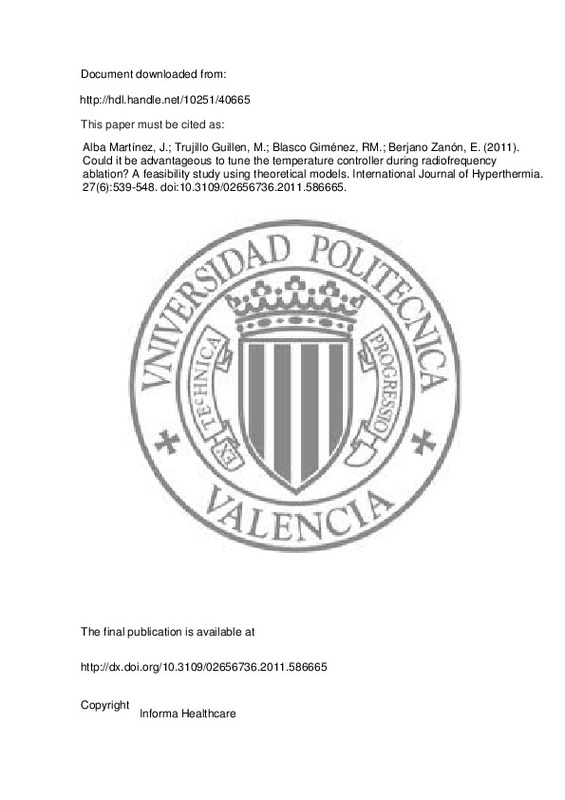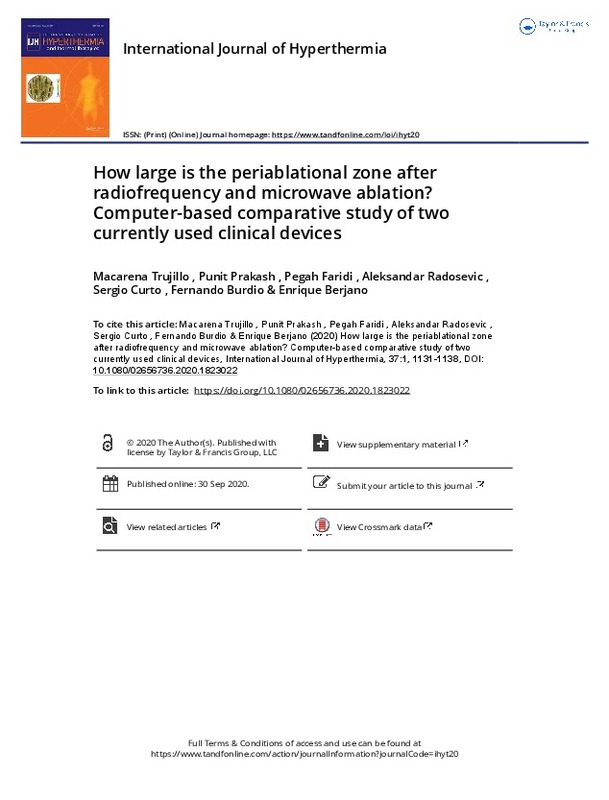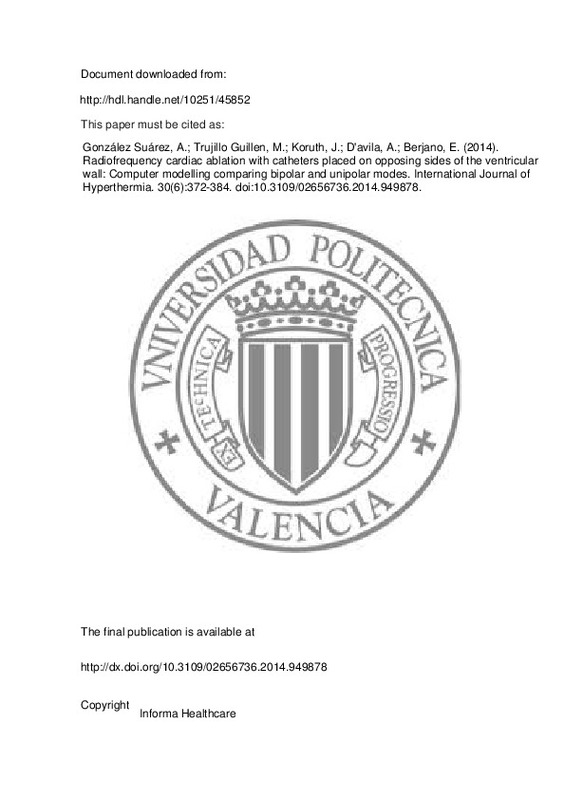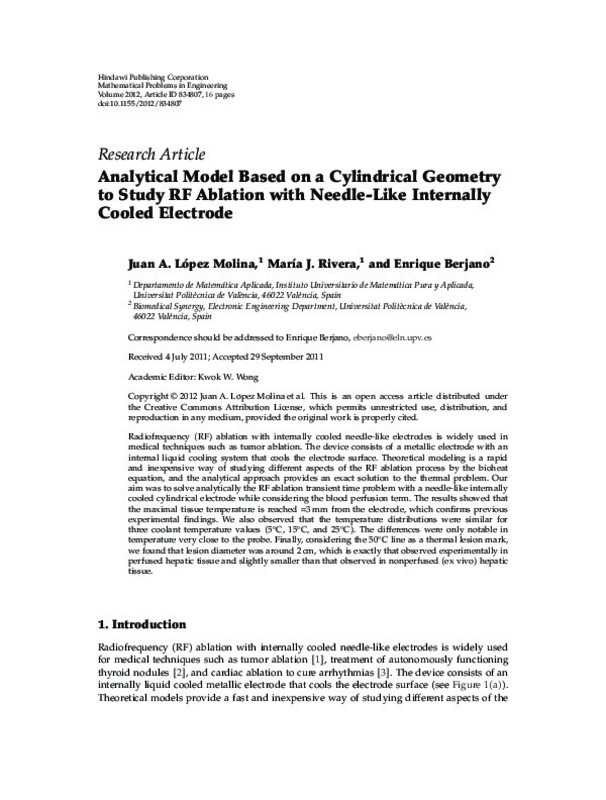Gaita, F., Caponi, D., Pianelli, M., Scaglione, M., Toso, E., Cesarani, F., … Leclercq, J. F. (2010). Radiofrequency Catheter Ablation of Atrial Fibrillation: A Cause of Silent Thromboembolism? Circulation, 122(17), 1667-1673. doi:10.1161/circulationaha.110.937953
Anfinsen, O.-G., Aass, H., Kongsgaard, E., Foerster, A., Scott, H., & Amlie, J. P. (1999). Journal of Interventional Cardiac Electrophysiology, 3(4), 343-351. doi:10.1023/a:1009840004782
PETERSEN, H. H., CHEN, X., PIETERSEN, A., SVENDSEN, J. H., & HAUNSO, S. (2000). Tissue Temperatures and Lesion Size During Irrigated Tip Catheter Radiofrequency Ablation: An In Vitro Comparison of Temperature-Controlled Irrigated Tip Ablation, Power-Controlled Irrigated Tip Ablation, and Standard Temperature-Controlled Ablation. Pacing and Clinical Electrophysiology, 23(1), 8-17. doi:10.1111/j.1540-8159.2000.tb00644.x
[+]
Gaita, F., Caponi, D., Pianelli, M., Scaglione, M., Toso, E., Cesarani, F., … Leclercq, J. F. (2010). Radiofrequency Catheter Ablation of Atrial Fibrillation: A Cause of Silent Thromboembolism? Circulation, 122(17), 1667-1673. doi:10.1161/circulationaha.110.937953
Anfinsen, O.-G., Aass, H., Kongsgaard, E., Foerster, A., Scott, H., & Amlie, J. P. (1999). Journal of Interventional Cardiac Electrophysiology, 3(4), 343-351. doi:10.1023/a:1009840004782
PETERSEN, H. H., CHEN, X., PIETERSEN, A., SVENDSEN, J. H., & HAUNSO, S. (2000). Tissue Temperatures and Lesion Size During Irrigated Tip Catheter Radiofrequency Ablation: An In Vitro Comparison of Temperature-Controlled Irrigated Tip Ablation, Power-Controlled Irrigated Tip Ablation, and Standard Temperature-Controlled Ablation. Pacing and Clinical Electrophysiology, 23(1), 8-17. doi:10.1111/j.1540-8159.2000.tb00644.x
Tungjitkusolmun, S., Woo, E. J., Cao, H., Tsai, J. Z., Vorperian, V. R., & Webster, J. G. (2000). Thermal—electrical finite element modelling for radio frequency cardiac ablation: Effects of changes in myocardial properties. Medical & Biological Engineering & Computing, 38(5), 562-568. doi:10.1007/bf02345754
Lai, Y.-C., Choy, Y. B., Haemmerich, D., Vorperian, V. R., & Webster, J. G. (2004). Lesion Size Estimator of Cardiac Radiofrequency Ablation at Different Common Locations With Different Tip Temperatures. IEEE Transactions on Biomedical Engineering, 51(10), 1859-1864. doi:10.1109/tbme.2004.831529
Jain, M. K., & Wolf, P. D. (1999). Temperature-controlled and constant-power radio-frequency ablation: what affects lesion growth? IEEE Transactions on Biomedical Engineering, 46(12), 1405-1412. doi:10.1109/10.804568
Panescu, D., Whayne, J. G., Fleischman, S. D., Mirotznik, M. S., Swanson, D. K., & Webster, J. G. (1995). Three-dimensional finite element analysis of current density and temperature distributions during radio-frequency ablation. IEEE Transactions on Biomedical Engineering, 42(9), 879-890. doi:10.1109/10.412649
Hong Cao, Vorperian, V. R., Tungjitkusolmun, S., Jan-Zern Tsai, Haemmerich, D., Young Bin Choy, & Webster, J. G. (2001). Flow effect on lesion formation in RF cardiac catheter ablation. IEEE Transactions on Biomedical Engineering, 48(4), 425-433. doi:10.1109/10.915708
Tungjitkusolmun, S., Vorperian, V. R., Bhavaraju, N., Cao, H., Tsai, J.-Z., & Webster, J. G. (2001). Guidelines for predicting lesion size at common endocardial locations during radio-frequency ablation. IEEE Transactions on Biomedical Engineering, 48(2), 194-201. doi:10.1109/10.909640
Schutt, D., Berjano, E. J., & Haemmerich, D. (2009). Effect of electrode thermal conductivity in cardiac radiofrequency catheter ablation: A computational modeling study. International Journal of Hyperthermia, 25(2), 99-107. doi:10.1080/02656730802563051
Langberg, J. J., Calkins, H., el-Atassi, R., Borganelli, M., Leon, A., Kalbfleisch, S. J., & Morady, F. (1992). Temperature monitoring during radiofrequency catheter ablation of accessory pathways. Circulation, 86(5), 1469-1474. doi:10.1161/01.cir.86.5.1469
Calkins, H., Prystowsky, E., Carlson, M., Klein, L. S., Saul, J. P., & Gillette, P. (1994). Temperature monitoring during radiofrequency catheter ablation procedures using closed loop control. Atakr Multicenter Investigators Group. Circulation, 90(3), 1279-1286. doi:10.1161/01.cir.90.3.1279
Lennox CD, Temperature controlled RF coagulation. Patent number: 5.122.137 Hudson NH
Edwards SD, Stern RA, Electrode and associated system using thermally insulated temperature sensing elements. Patent number: US Patent 5,456,682
Panescu D, Fleischman SD, Whayne JG, Swanson DK, (EP Technology. Effects of temperature sensor placement on performance of temperature-controlled ablation. IEEE 17th Annual Conference, Engineering in Medicine and Biology Society, Montreal, Canada (1995)
BLOUIN, L. T., MARCUS, F. I., & LAMPE, L. (1991). Assessment of Effects of a Radiofrequency Energy Field and Thermistor Location in an Electrode Catheter on the Accuracy of Temperature Measurement. Pacing and Clinical Electrophysiology, 14(5), 807-813. doi:10.1111/j.1540-8159.1991.tb04111.x
Berjano, E. J. (2006). BioMedical Engineering OnLine, 5(1), 24. doi:10.1186/1475-925x-5-24
Bhavaraju, N. C., Cao, H., Yuan, D. Y., Valvano, J. W., & Webster, J. G. (2001). Measurement of directional thermal properties of biomaterials. IEEE Transactions on Biomedical Engineering, 48(2), 261-267. doi:10.1109/10.909647
Hong Cao, Tungjitkusolmun, S., Young Bin Choy, Jang-Zern Tsai, Vorperian, V. R., & Webster, J. G. (2002). Using electrical impedance to predict catheter-endocardial contact during RF cardiac ablation. IEEE Transactions on Biomedical Engineering, 49(3), 247-253. doi:10.1109/10.983459
PETERSEN, H. H., & SVENDSEN, J. H. (2003). Can Lesion Size During Radiofrequency Ablation Be Predicted By the Temperature Rise to a Low Power Test Pulse in Vitro? Pacing and Clinical Electrophysiology, 26(8), 1653-1659. doi:10.1046/j.1460-9592.2003.t01-1-00248.x
LANGBERG, J. J., LEE, M. A., CHIN, M. C., & ROSENQVIST, M. (1990). Radiofrequency Catheter Ablation: The Effect of Electrode Size on Lesion Volume In Vivo. Pacing and Clinical Electrophysiology, 13(10), 1242-1248. doi:10.1111/j.1540-8159.1990.tb02022.x
[-]







![[Cerrado]](/themes/UPV/images/candado.png)





